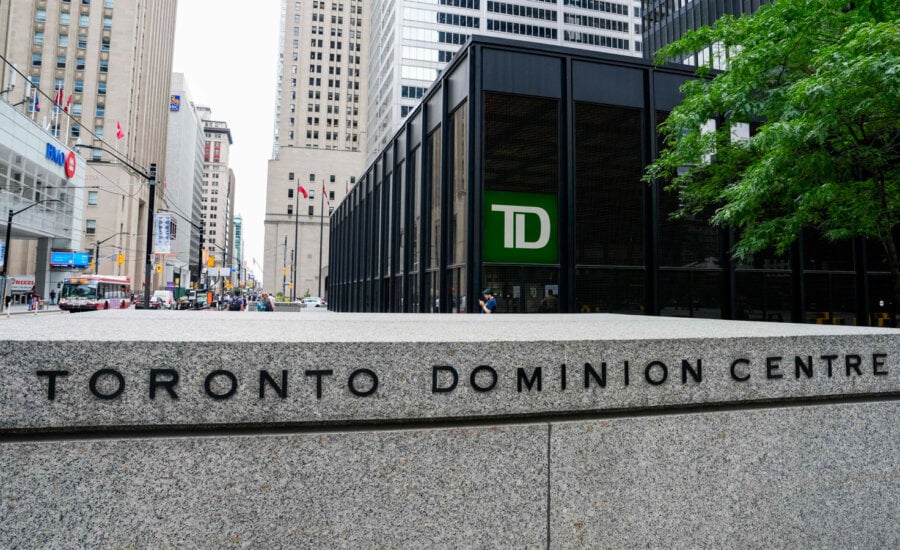Why is TD’s profit down?
TD Bank Group reports profits down 22% on anti-money laundering hit.
Advertisement
TD Bank Group reports profits down 22% on anti-money laundering hit.

TD Bank Group’s second-quarter profit fell 22% from last year as it booked costs related to a high-profile failure of its U.S. anti-money laundering program. The bank had warned of the $615-million initial charge it was taking in connection with its talks with U.S. regulators, allowing analysts to adjust projections that the bank then handily beat. “It was a strong quarter for TD with all of our businesses outperforming expectations,” said chief executive Bharat Masrani on an earnings call Thursday, after reiterating the bank’s mea culpa on its anti-money laundering controls. (Is TD a good stock to buy right now?)
Despite repeated questioning from analysts, the bank didn’t provide any new information such as timelines or expected penalties on the multiple investigations it faces in the U.S., but Masrani said the bank is doing all it can to help wrap them up.
News from TD’s earnings call on Thursday, May 23.
“We have freely shared all information we have with the Department of Justice and other U.S. regulators, even when it demonstrated our weaknesses,” he said.
Were it not for the money laundering issue, which the bank has already spent $500 million to fix, the quarter would have looked quite different. The bank reported net income of $2.56 billion or $1.35 per diluted share for the quarter ended April 30, down from $3.31 billion or $1.69 per diluted share in the same quarter last year.
Adjusting for the charges and other outliers, TD said it earned $2.04 per diluted share, up from an adjusted profit of $1.91 per diluted share a year earlier.
The results, helped by a 10% rise in revenue to $13.82 billion, were well above the average analyst estimate of $1.85 per share, according to data provided by LSEG Data & Analytics.
“A big beat with a big asterisk,” wrote Scotiabank analyst Meny Grauman in a note. He said the results were mixed, given the beat was driven mostly by better-than-expected expenses and lower taxes, while the anti-money laundering issues still loom large. While the U.S. regulatory issues are a concern, the potential impact on business in its biggest growth market is a longer-term risk. Grauman said he didn’t see signs of that yet in the latest results. The possibility remains though.
According to a report by the Wall Street Journal that TD hasn’t refuted, the U.S. Justice Department investigation is focused on how Chinese drug traffickers allegedly used TD to launder at least US$653 million and bribed TD employees to do so.
The seriousness of the allegations means the bank’s cumulative fines could easily hit $2 billion and TD could also face restrictions, including limits on its balance sheet growth, that could affect bank operations for years, National Bank analyst Gabriel Dechaine said when the report surfaced in early May.
The Globe and Mail reported late Wednesday that the bank also faces orders from Canada’s banking regulator to fix its risk controls, prompting analysts to question if the bank faces more global problems.
Masrani pushed back against the report, saying the bank is in constant dialogue with regulators. “It is unfortunate that the report contains inaccuracies and misrepresents our normal course, business-as-usual interactions with Canadian regulators.
The Office of the Superintendent of Financial Institutions said it can’t comment on confidential actions or correspondence related to the entities it regulates.
The regulator did, however, point to recent comments by superintendent Peter Routledge where he outlined heightened expectations around bank integrity and security.
Higher costs related to anti-money laundering issues come as the bank winds down a restructuring program that saw it cut about 3% of staff. Charges for the program announced in November will total about $870 million, including $165 million pre-tax last quarter, while savings this year should run about $400 million pre-tax. Going forward, annual cost savings should come in around $725 million pre-tax, the bank said.
Dechaine said in a note that he reads the bank’s comments on the cost savings as offsetting anti-money laundering costs, at least partially. He said the financial results were neutral as the better-than-expected earnings could be partially explained by a large hedge gain, compared with a typical loss. Higher capital markets also helped, he said.
Overall, Dechaine said the cost overhang from anti-money laundering efforts will affect the bank’s capital and ability to buy back shares, and so downgraded the bank’s rating to underperform. “It could get tougher before it gets better,” he wrote.

Get up to 4.00% interest on your savings without any fees.

Lock in your deposit and earn a guaranteed interest rate of 3.55%.

Earn 3.9% interest for the first five months. No minimum balance required and no fees.
MoneySense is an award-winning magazine, helping Canadians navigate money matters since 1999. Our editorial team of trained journalists works closely with leading personal finance experts in Canada. To help you find the best financial products, we compare the offerings from over 12 major institutions, including banks, credit unions and card issuers. Learn more about our advertising and trusted partners.
TD’s provisions for credit losses of $1.07 billion came in higher than analyst expectations, but Dechaine noted that the cause was less severe performing provisions, while the bank actually came under on impaired provisions. Impaired provisions were up 58% from last year to $870 million, while performing provisions were more than three times higher than last year at $201 million.
The bank’s total provisions for the quarter amounted to about 0.47% of its credit volume.
Masrani said the bank, with a capital ratio of 13.4%, has the capital buffers to address uncertain market conditions and various scenarios that may play out this quarter. He said the bank is well positioned for a slower economy and will benefit from higher interest rates for longer, while focusing on the biggest tasks at hand.
“We delivered significant positive operating leverage, while continuing to execute on our restructuring program and prioritizing investments in our risk and control infrastructure.”
Share this article Share on Facebook Share on Twitter Share on Linkedin Share on Reddit Share on Email